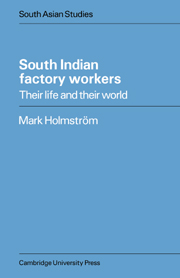2 - Bangalore and its factory workers
Published online by Cambridge University Press: 06 October 2009
Summary
Bangalore, the capital of Mysore State, lies on the Deccan plateau at an altitude of 900 metres, 350 kilometres west of Madras and about the same distance east of Mangalore on the Arabian Sea.
The city was founded in the sixteenth century. In the nineteenth century the British built a Cantonment, or Civil and Military Station, outside the old town, with broad avenues, rambling bungalows, italianate or gothic churches, and parks (once Churchill, who was once stationed there, called it ‘a dreary watering place’). This Cantonment was governed as part of ‘British India’, and a town grew up around it. The old city was in the dominions of the Maharaja of Mysore, who made it his capital. The two halves of Bangalore were merged under a single municipal corporation after Independence in 1947. Both the old city and the Cantonment, like many surrounding villages, have been swallowed up in the rapid growth of Bangalore since then.
Before the British conquest, Bangalore was already one of the chief manufacturing and trading towns of South India, making handloom textiles, carpets and luxury goods. The first powered factories were two textile mills founded in the 1880s, in the Maharaja's part of the city. From then on the state government, under a succession of enlightened Dewans (prime ministers), gave financial and practical support to new industries, and planned to follow the example of the Japanese Meiji government by setting up state factories and selling them off when they become going concerns. Thus the government started factories making soap, porcelain, light-bulbs and transformers: but it made no serious efforts to sell them.
- Type
- Chapter
- Information
- South Indian Factory WorkersTheir Life and their World, pp. 8 - 26Publisher: Cambridge University PressPrint publication year: 1976

